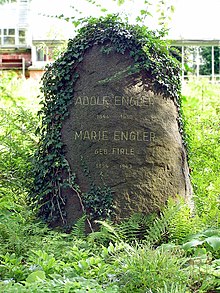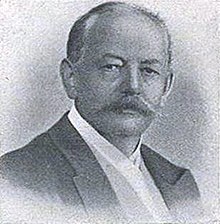Adolf Engler
Heinrich Gustav Adolf Engler (born March 25, 1844 in Sagan , Lower Silesia, † October 10, 1930 in Berlin ) was a German botanist and the leading plant expert of his time. Its official botanical author's abbreviation is " Engl. "
Live and act

Born in Sagan (Polish: Żagań) in Lower Silesia, he came to Breslau (Polish: Wrocław) in 1848 with his parents, August and Pauline Engler . Here he attended the Maria-Magdalenen-Gymnasium until his Abitur in 1863 . During his studies in Munich in 1866 he became a member of the Algovia fraternity . In 1866 Adolf Engler received his doctorate as Dr. phil. at the University of Wroclaw . From 1871 to 1878 he was a lecturer and herbarium curator in Munich. In 1878 he was elected to the German Academy of Sciences Leopoldina . From 1878 to 1884 he taught systematic botany at the University of Kiel , where he first laid out a botanical garden . Then he succeeded his doctoral supervisor Heinrich Göppert as director of the Botanical Garden (1884–1889) in Breslau . At the age of 45 he took over a full professorship for systematic botany at the Friedrich-Wilhelms-Universität in Berlin in October 1889 and with this position also became director of the Royal Botanical Garden and Museum in Schöneberg .
In 1900 he moved the Berlin Botanical Garden from Schöneberg to Dahlem and created Germany's largest and most important botanical garden with around 20,000 species with this 43 hectare site. A year earlier, at the request of Governor Julius Freiherr von Soden , he had been able to establish the Central Botanical Office for the German colonies .
Engler traveled to Algeria and Tunisia in 1889 , the Canary Islands in 1901 , South and East Africa in 1902 and 1905 and tropical Asia in 1906 . In 1913 he went on a trip around the world.
In 1880, Engler founded the Botanical Yearbooks , which he was editor of until 1930. The botanical yearbooks are among the most important botanical treatises of all and are of inestimable value for botanists and taxonomists to this day (see the systematics of plants according to Engler ).
Engler also attempted to summarize the flora and vegetation of the whole earth in individual works. Despite the large number of employees, this was only partially successful. The work The Natural Plant Families , which he edited together with Karl Anton Eugen Prantl between 1887 and 1915, has been published in full. Of the series Die Vegetation der Erde , which he published together with Carl Georg Oscar Drude in the years 1896–1923, 15 volumes have appeared. The work The Plant Kingdom , which was supposed to include all species of the earth, was started in 1900 and continued after his death. By 1953, 107 volumes of the work had come out.
Several later famous botanists such as Richard Kolkwitz , Hermann Morstatt (1877–1958), Karl-Otto Müller and Friedrich Richard Schaudinn studied with Adolf Engler. Franz Josef Niedenzu , Ferdinand Albin Pax (1858–1942), Wilhelm Ruhland , Julius Schuster and Georg Volkens (1855–1917) were scientific assistants at Engler.
In accordance with his own wishes, he found his final resting place in the Botanical Garden in Berlin. It was dedicated to the city of Berlin as a grave of honor until 2009 .
Honors
In 1901 Engler was elected to the American Academy of Arts and Sciences , in 1906 to the American Philosophical Society and in 1925 to the National Academy of Sciences . In 1912 he became a corresponding member of the Académie des Sciences in Paris. In 1913 he was awarded the Linnean Medal of the Linnean Society of London .
The plant genera Englerastrum Briq. from the family of mint (Lamiaceae), Englerarum Nauheim & PCBoyce from the family of the arum family (Araceae), Engler Ella Pierre and Englerophytum K.Krause from the family of sapotaceae (Sapotaceae), Engleria O. Hoffm. from the sunflower family (Asteraceae), Englerina Tiegh. from the family of the belt flowers (Loranthaceae), Englerocharis Muschl. from the family Cruciferae (Brassicaceae), Englerodoxa Hoerold of the family Ericaceae (Ericaceae) Englerodaphne Gilg , from the family of Thymelaeaceae (Thymelaeaceae) Englerophoenix Kuntze from the family of Palm (Arecaceae) and Englerodendron Harms from the family of legumes (Fabaceae) have been named after him. The mushroom genera Engleromyces Henn. , Englerula Henn. , Englerulella Hansf. and Parenglerula Höhn. have been named in honor of Englers.
The Englera magazine published by the Botanical Garden and Botanical Museum Berlin-Dahlem also bears his name. In 1938 a street leading to the Botanical Museum was renamed Englerallee.
Works (selection)
- The plant formations and plant-geographical structure of the Alpine chain , explained on the Alpine layout of the new Royal Botanical Garden in Dahlem-Steglitz near Berlin, in: Notblatt des Königl. Botanical Garden and Museum in Berlin , Appendix VII, February 28, 1901, Engelmann, Leipzig 1901
- Expert opinion on the Royal Botanical Garden in Berlin and on the question of its relocation . In: Notblatt des Königl. Botanical Garden and Museum in Berlin , Vol. 1, No. 10, Engelmann, Leipzig 1897, p. 295 ff.
literature
- Botanical Museum Berlin: Adolf Engler - The world in a garden . Prestel, Munich 2000. ISBN 3-7913-2315-6
- Frans A. Stafleu, Richard S. Cowan: Taxonomic literature . 2nd ed., Volume 1, A-G, pages 757-797. Utrecht 1976, ISBN 90-313-0225-2 .
- Friedrich Margrave : Engler, Adolf. In: New German Biography (NDB). Volume 4, Duncker & Humblot, Berlin 1959, ISBN 3-428-00185-0 , p. 532 ( digitized version ).
Web links
- Literature by and about Adolf Engler in the catalog of the German National Library
- Literature by and about Adolf Engler in the catalog of the Virtual Library of Biology (vifabio)
- Author entry and list of the described plant names for Adolf Engler at the IPNI
- Special exhibition 2000 The world in a garden / Adolf Engler - a life for botany in the Botanical Museum Berlin
- Engler's biography as part of the 1998 special exhibition The Green Treasury of the Free University of Berlin in the Botanical Museum Berlin
- Botanical yearbooks for systematics, plant history and plant geography by Adolf Engler, ed. by J. Grau u. a. Schweizerbart'sche publishing bookstore
- Selected references from d. Stock d. Academy library in the Berlin-Brandenburg Academy of Sciences and Humanities (PDF; 118 kB)
Individual evidence
- ^ Karl Gareis: The Munich fraternity Arminia - becoming and fate. Munich 1967, p. 145.
- ↑ Member History: Adolf Engler. American Philosophical Society, accessed August 1, 2018 .
- ^ List of members since 1666: Letter E. Académie des sciences, accessed on February 9, 2020 (French).
- ↑ a b Lotte Burkhardt: Directory of eponymic plant names - extended edition. Part I and II. Botanic Garden and Botanical Museum Berlin , Freie Universität Berlin , Berlin 2018, ISBN 978-3-946292-26-5 doi: 10.3372 / epolist2018 .
- ↑ Robert Zander : Zander hand dictionary of plant names. Edited by Fritz Encke , Günther Buchheim, Siegmund Seybold . 13th, revised and expanded edition. Eugen Ulmer, Stuttgart 1984, ISBN 3-8001-5042-5 .
- ↑ Englerallee. In: Street name lexicon of the Luisenstädtischer Bildungsverein (near Kaupert )
| personal data | |
|---|---|
| SURNAME | Engler, Adolf |
| ALTERNATIVE NAMES | Engler, Heinrich Gustav Adolf |
| BRIEF DESCRIPTION | German botanist |
| DATE OF BIRTH | March 25, 1844 |
| PLACE OF BIRTH | Sagan (today's Żagań in Poland) |
| DATE OF DEATH | October 10, 1930 |
| Place of death | Berlin |
